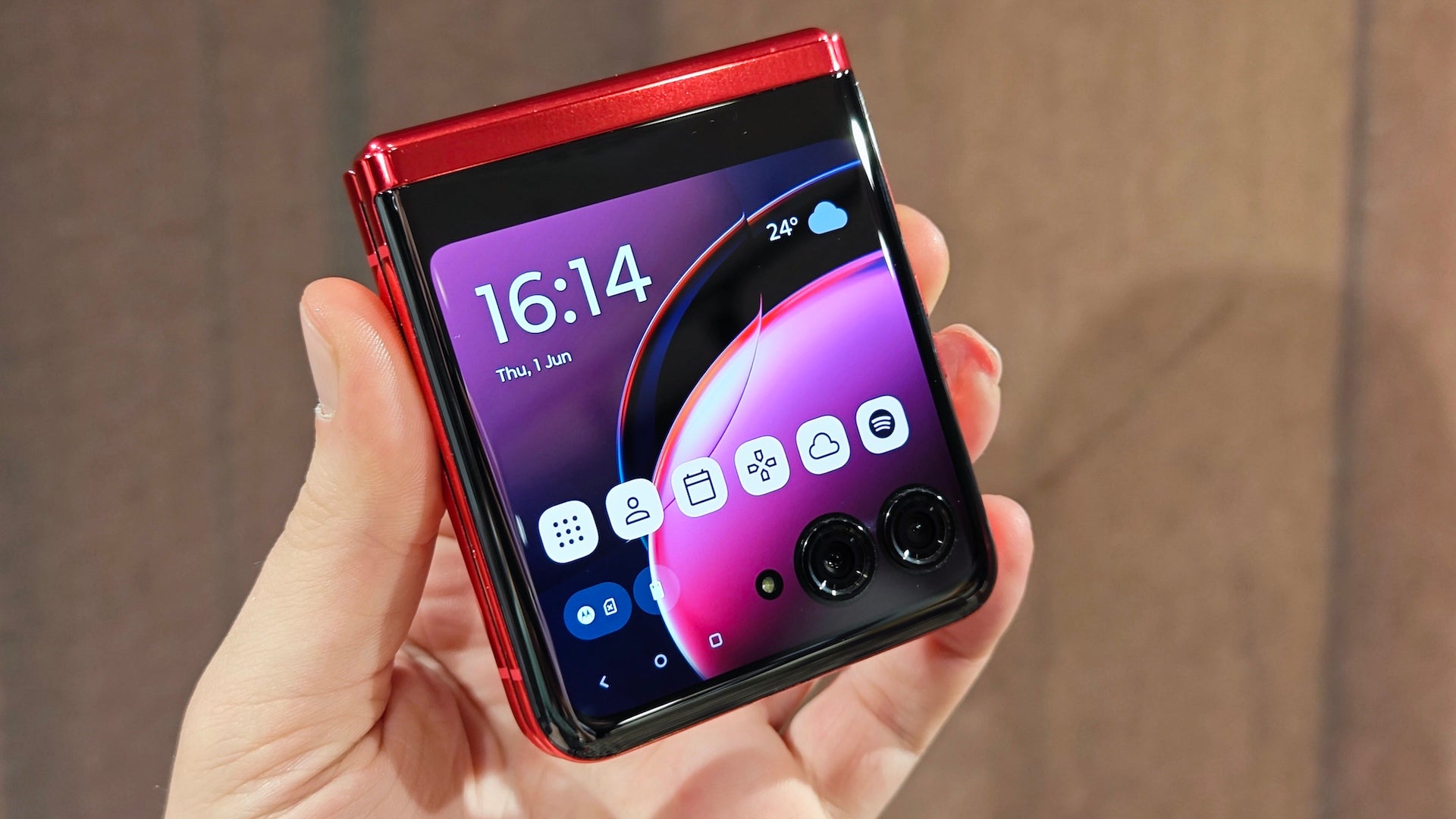First Impressions
The Motorola Razr 40 Ultra could be an instant winner, but odd spec choices mean it might be surpassed in a matter of months rather than years. Still, the large 3.6-inch external display is a game-changer for clamshells, and I’d love to see it appear on others in due course.
Introduction
Motorola has just announced the Razr 40 Ultra alongside the budget-friendly Razr 40, offering a number of firsts for foldables including the biggest, fastest external display to date at 3.6 inches and 144Hz, but is there more to it than a big external display?
While it might not look all that different from its predecessor, the Razr 40 Ultra represents the peak of Motorola’s design prowess with an elegant design, premium materials and one of the least noticeable creases I’ve seen to date.
I’m not quite ready to deliver my final verdict, spending just 12 hours with the Razr 40 Ultra wandering around the streets of Madrid, but I’m very excited by what I’ve seen so far, and I’m confident that Motorola has a winner on its hands.
Here are my initial impressions of the Motorola Razr 40 Ultra ahead of a full review in the coming days.
Design and Screen
- Premium foldable design
- Largest external display around at 3.6 inches
- Huge internal 6.9-inch pOLED 165Hz panel
The Motorola Razr 40 Ultra certainly has the same Razr feel as the 2022 model, but it feels much more refined, premium and lightweight this time around — and not just because of that huge external display.
There’s a new hinge system at play here that Motorola claims is doing a number of things; it allows the phone to fold without a gap, dramatically reduces the look of the crease and gets rid of the sensation you get when running your finger over it. Those are bold claims, but I must admit, the company has done something impressive.
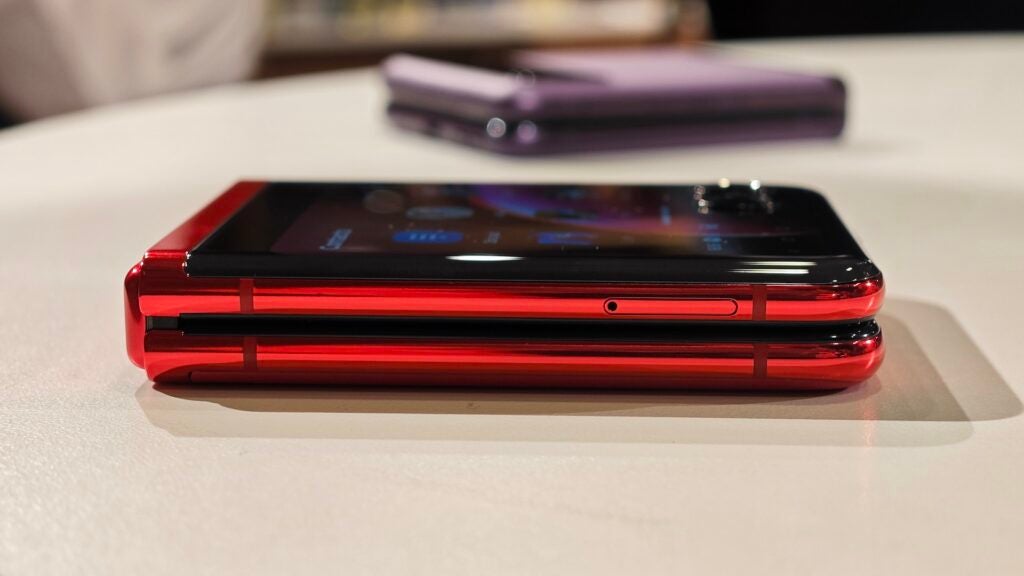
I will say that while it’s almost completely gapless, you do still see a slither of light shine through when holding it up against bright light, but it’s a massive step forward from the rather large gap found in the 2022 Razr, and should seriously reduce the amount of dust and detritus that builds up on that inner foldable display.
The crease, on the other hand, is a masterpiece. It’s just about there if you look at it off-angle and try and catch it in the light but, looking straight on, you’d barely tell that the display could fold in half. It’s a similar story with the hinge — you can notice something when running your finger over the crease but it doesn’t feel obvious or intrusive.
It also allows the Razr 40 Ultra to hold the title of the thinnest clamshell smartphone when fully folded, according to Motorola. It does feel nice and pocketable despite the gargantuan 6.9-inch panel found within.
Of course, it is all about the displays and let’s start with that outer panel. It’s the largest of any clamshell foldable now measuring in at a whopping 3.6 inches, and it’s not simply a big screen either.
Boasting pOLED tech and an incredible 144Hz refresh rate not seen on any other clamshell, the exterior display sits in a league of its own. It has a dual camera cutout in the bottom-right or top-left depending on your orientation, which can sometimes get in the way, but it’s something I think most people will happily live with.
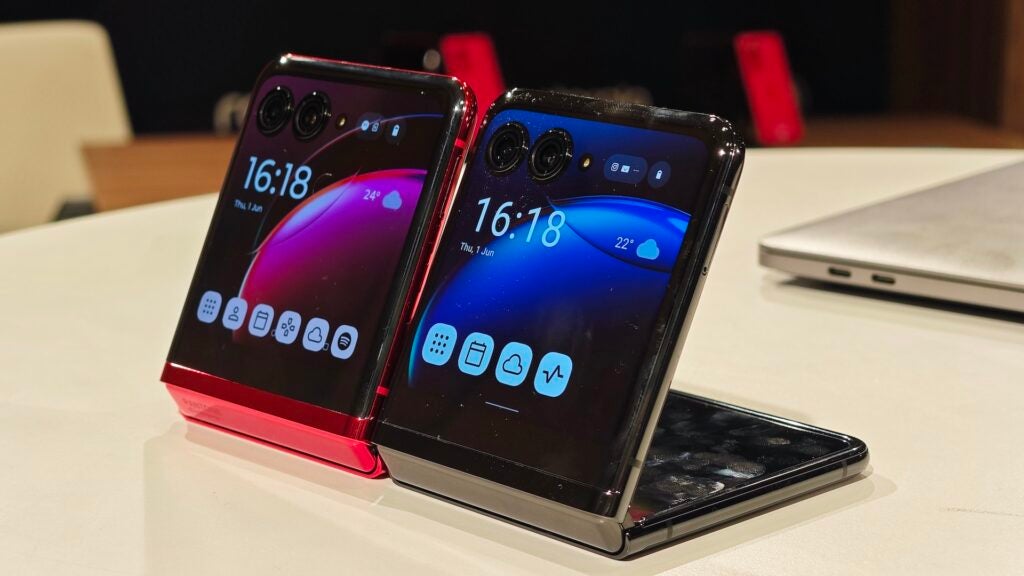
The external display also has a new layout with new widgets and the ability to run any Android app you’d like, making it much easier to reply to WhatsApp messages or quickly like a tweet without unfolding the phone.
It’s a similar story with the internal display; it’s not just big for the sake of it. It’s a high-end 6.9-inch pOLED display with flagship features including a 165Hz refresh rate with LTPO support and HDR10+ that has so far delivered a bright, crisp visual experience, though that has been limited to apps like WhatsApp, Slack, Instagram and TikTok for now — I’ll be binging Netflix for the full review so head back soon for my final thoughts on the impressive display combo.
Cameras
- Twin 12MP rear cameras
- 32MP selfie camera
- F/1.5 aperture is among the best around
The Motorola Razr 40 Ultra’s dual 12MP rear camera offering may not be able to take on the likes of the Oppo Find N2 Flip on paper, but there’s much more to cameras than megapixel count. Interestingly, the highest resolution sensor seems to be the internal selfie camera — aka the one many people will use least — clocking in at 32MP.
The main 12MP snapper seems to do an admirable job in well-lit scenarios like the below shots of the streets of Madrid, with great vibrancy and plenty of light thanks to that wide f/1.5 aperture and OIS capabilities.
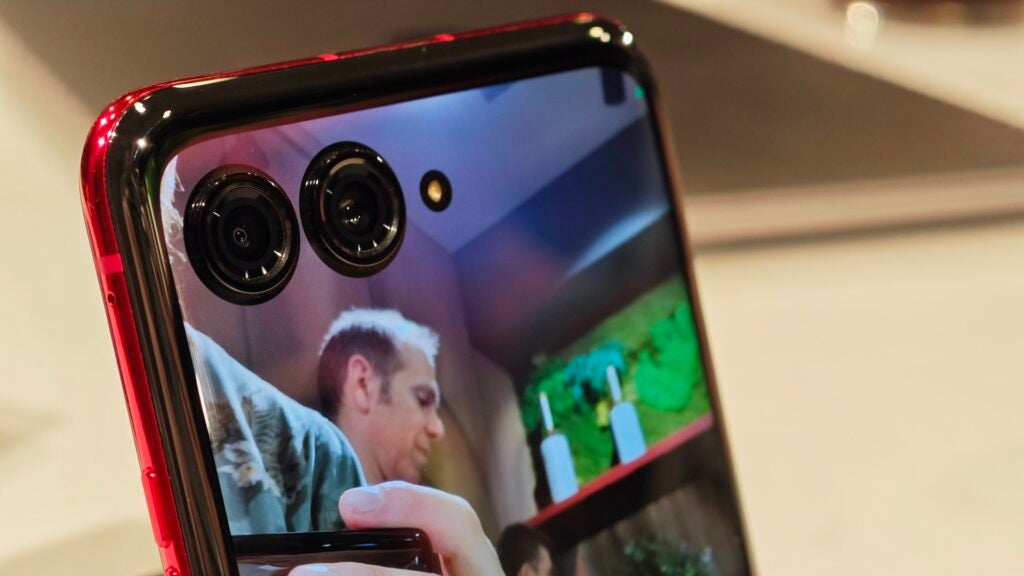
I’ll also be interested to see how well the Razr 40 Ultra performs in low-light conditions as, with such a wide aperture, it could deliver serious improvements over low-light photography on most other foldables. I’ll have to put that to the test for the full review.
It’s hard to tell whether Motorola has done any meaningful work with the accompanying 13MP ultrawide lens, sporting the same resolution and wide angle as the Razr (2022). There are at least some new software smarts, with the phone able to use the ultrawide lens to snap macro photography for extreme close-up action.
The good thing about the foldable form factor is that you can use the rear-facing cameras as selfie cameras, complete with a digital viewfinder on the 3.6-inch external display, allowing for high-end selfies on both the main and ultrawide lenses. It can also be placed on a table and opened halfway for a makeshift tripod.
If you don’t like the idea of using the rear-facing cameras to take selfies — or you like to chat a lot via video call — then the 32MP internal selfie camera should suffice. My limited selfies so far seem crisp and, crucially, lack the washed-out colour palette sometimes present on Motorola selfie cameras, and it’ll be more than enough for video calling too.
Performance
- Snapdragon 8 Plus Gen 1 chipset
- Close-to-stock Android 13 experience
- 3800mAh battery
Surprisingly considering the smartphone’s ‘Ultra’ moniker that usually suggests the best of the best, the chipset found within the Razr 40 Ultra isn’t the most powerful one that money can buy. No, instead, the smartphone sports the (nearly one-year-old) Snapdragon 8 Plus Gen 1 chipset — the same as that found in the previous-gen Razr (2022) and other 2022 foldables like Samsung’s Galaxy Z Flip 4.
Now, that’s not to say that performance isn’t solid — the smartphone is yet to show even a hint of stutter or lag during standard use — but it does feel like an area where Motorola could’ve scored an easy win, especially as I expect Samsung’s upcoming Z Flip 5 to use the same exclusive Snapdragon 8 Gen 2 for Galaxy chipset as the flagship S23 range.
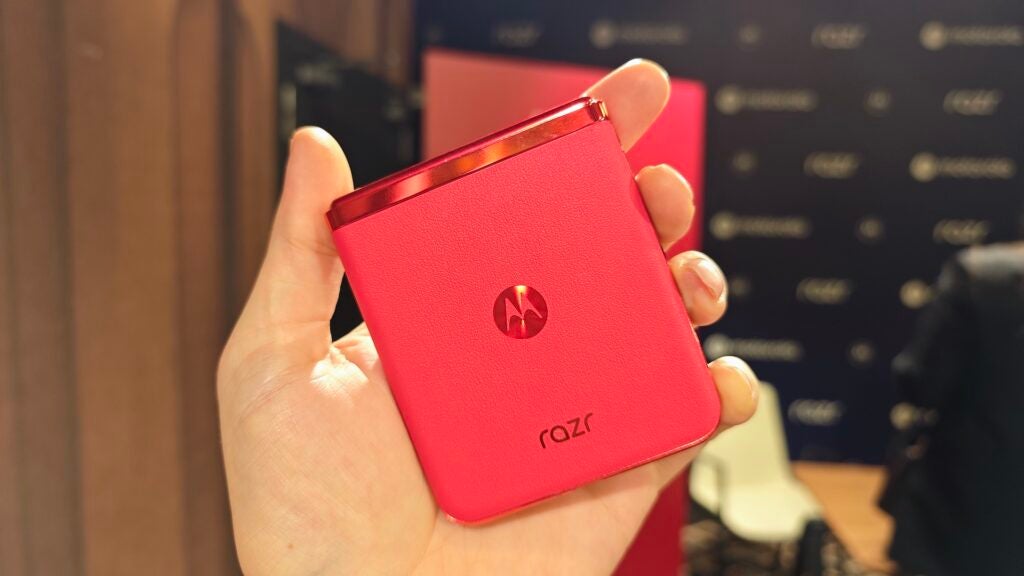
So, while it’s very much a premium experience for now, I expect the competition to surpass the processing power of Motorola’s top-end foldable in the coming months. Not great for one of the most expensive flip-style foldables around right now…
Regardless, that Snapdragon chipset is paired with a rather healthy (but not leading) 8GB of RAM and 256GB of storage for those that need it. Probably a good thing too, considering the lack of a microSD card to expand storage further down the road.
I’ve not had a chance to game on the smartphone just yet, nor have I benchmarked it — both of those will come with the full review in the coming days — but I’m confident of its performance, especially coupled with that buttery-smooth 165Hz refresh rate.
Audio performance also seems to be rather strong with pretty decent amounts of volume delivered from the clamshell, and Dolby Atmos support on offer when listening to music via headphones further enhances the experience.
Motorola is famed for its near-stock approach to Android, rivalled only by the likes of Nokia and Google itself, and that’s just as true with the Razr 40 Ultra as other Android 13 devices like the Motorola Edge 40.
Everything I said there is just as true here; the approach to Android 13 is so close to stock that you’ll find very little to complain about, and where there are tweaks, these are usually for the benefit of the end user.
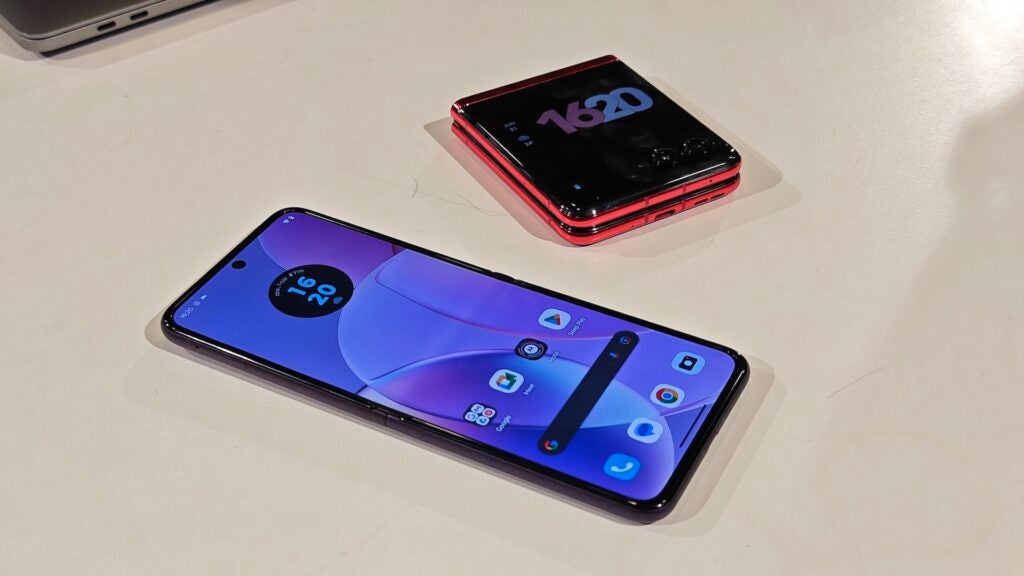
This includes features like Moto Gestures that allows quick access to the torch and camera to ReadyFor, Motorola’s Windows companion software that allows you to run your favourite Android apps, reply to messages and even use the phone’s camera as a webcam when connected to Windows 10 or Windows 11 devices.
Battery life should be marginally better than the Razr (2022) with a slightly larger 3800mAh cell, though it’s still a way off the 4300mAh of the Oppo Find N2 Flip and far from the 5000mAh cell you’ll find in most candy bar flagships.
I’ve not yet used the phone for long enough to give any real indication of battery life, but one of the big improvements of the Snapdragon 8 Plus Gen 1 was power efficiency, so I don’t doubt that the Razr will last all day. I’ll be sure to report back in the coming days either way.
Rather disappointingly, however, the Razr 40 Ultra charges at the same 30W as its predecessor, meaning it’ll probably take around an hour to go from flat to full. The saving grace? At least the 30W charger and USB-C cable come in the box.
Latest deals
Early Thoughts
The Motorola Razr 40 Ultra takes what I liked about the Razr (2022) and took it to the next level, especially where that outer display is concerned. It’s not only the biggest and fastest of all current clamshells but it allows you to access full Android apps, reply to texts and more without having to unfold the device.
It’s a similar story with the overall design, new hinge and improved display, all pointing towards a very capable flagship clamshell foldable, but I’ll save my final thoughts for the full review coming very soon.
Full specs
First Impressions
The Motorola Razr 40 Ultra could be an instant winner, but odd spec choices mean it might be surpassed in a matter of months rather than years. Still, the large 3.6-inch external display is a game-changer for clamshells, and I’d love to see it appear on others in due course.
Introduction
Motorola has just announced the Razr 40 Ultra alongside the budget-friendly Razr 40, offering a number of firsts for foldables including the biggest, fastest external display to date at 3.6 inches and 144Hz, but is there more to it than a big external display?
While it might not look all that different from its predecessor, the Razr 40 Ultra represents the peak of Motorola’s design prowess with an elegant design, premium materials and one of the least noticeable creases I’ve seen to date.
I’m not quite ready to deliver my final verdict, spending just 12 hours with the Razr 40 Ultra wandering around the streets of Madrid, but I’m very excited by what I’ve seen so far, and I’m confident that Motorola has a winner on its hands.
Here are my initial impressions of the Motorola Razr 40 Ultra ahead of a full review in the coming days.
Design and Screen
- Premium foldable design
- Largest external display around at 3.6 inches
- Huge internal 6.9-inch pOLED 165Hz panel
The Motorola Razr 40 Ultra certainly has the same Razr feel as the 2022 model, but it feels much more refined, premium and lightweight this time around — and not just because of that huge external display.
There’s a new hinge system at play here that Motorola claims is doing a number of things; it allows the phone to fold without a gap, dramatically reduces the look of the crease and gets rid of the sensation you get when running your finger over it. Those are bold claims, but I must admit, the company has done something impressive.

I will say that while it’s almost completely gapless, you do still see a slither of light shine through when holding it up against bright light, but it’s a massive step forward from the rather large gap found in the 2022 Razr, and should seriously reduce the amount of dust and detritus that builds up on that inner foldable display.
The crease, on the other hand, is a masterpiece. It’s just about there if you look at it off-angle and try and catch it in the light but, looking straight on, you’d barely tell that the display could fold in half. It’s a similar story with the hinge — you can notice something when running your finger over the crease but it doesn’t feel obvious or intrusive.
It also allows the Razr 40 Ultra to hold the title of the thinnest clamshell smartphone when fully folded, according to Motorola. It does feel nice and pocketable despite the gargantuan 6.9-inch panel found within.
Of course, it is all about the displays and let’s start with that outer panel. It’s the largest of any clamshell foldable now measuring in at a whopping 3.6 inches, and it’s not simply a big screen either.
Boasting pOLED tech and an incredible 144Hz refresh rate not seen on any other clamshell, the exterior display sits in a league of its own. It has a dual camera cutout in the bottom-right or top-left depending on your orientation, which can sometimes get in the way, but it’s something I think most people will happily live with.

The external display also has a new layout with new widgets and the ability to run any Android app you’d like, making it much easier to reply to WhatsApp messages or quickly like a tweet without unfolding the phone.
It’s a similar story with the internal display; it’s not just big for the sake of it. It’s a high-end 6.9-inch pOLED display with flagship features including a 165Hz refresh rate with LTPO support and HDR10+ that has so far delivered a bright, crisp visual experience, though that has been limited to apps like WhatsApp, Slack, Instagram and TikTok for now — I’ll be binging Netflix for the full review so head back soon for my final thoughts on the impressive display combo.
Cameras
- Twin 12MP rear cameras
- 32MP selfie camera
- F/1.5 aperture is among the best around
The Motorola Razr 40 Ultra’s dual 12MP rear camera offering may not be able to take on the likes of the Oppo Find N2 Flip on paper, but there’s much more to cameras than megapixel count. Interestingly, the highest resolution sensor seems to be the internal selfie camera — aka the one many people will use least — clocking in at 32MP.
The main 12MP snapper seems to do an admirable job in well-lit scenarios like the below shots of the streets of Madrid, with great vibrancy and plenty of light thanks to that wide f/1.5 aperture and OIS capabilities.

I’ll also be interested to see how well the Razr 40 Ultra performs in low-light conditions as, with such a wide aperture, it could deliver serious improvements over low-light photography on most other foldables. I’ll have to put that to the test for the full review.
It’s hard to tell whether Motorola has done any meaningful work with the accompanying 13MP ultrawide lens, sporting the same resolution and wide angle as the Razr (2022). There are at least some new software smarts, with the phone able to use the ultrawide lens to snap macro photography for extreme close-up action.
The good thing about the foldable form factor is that you can use the rear-facing cameras as selfie cameras, complete with a digital viewfinder on the 3.6-inch external display, allowing for high-end selfies on both the main and ultrawide lenses. It can also be placed on a table and opened halfway for a makeshift tripod.
If you don’t like the idea of using the rear-facing cameras to take selfies — or you like to chat a lot via video call — then the 32MP internal selfie camera should suffice. My limited selfies so far seem crisp and, crucially, lack the washed-out colour palette sometimes present on Motorola selfie cameras, and it’ll be more than enough for video calling too.
Performance
- Snapdragon 8 Plus Gen 1 chipset
- Close-to-stock Android 13 experience
- 3800mAh battery
Surprisingly considering the smartphone’s ‘Ultra’ moniker that usually suggests the best of the best, the chipset found within the Razr 40 Ultra isn’t the most powerful one that money can buy. No, instead, the smartphone sports the (nearly one-year-old) Snapdragon 8 Plus Gen 1 chipset — the same as that found in the previous-gen Razr (2022) and other 2022 foldables like Samsung’s Galaxy Z Flip 4.
Now, that’s not to say that performance isn’t solid — the smartphone is yet to show even a hint of stutter or lag during standard use — but it does feel like an area where Motorola could’ve scored an easy win, especially as I expect Samsung’s upcoming Z Flip 5 to use the same exclusive Snapdragon 8 Gen 2 for Galaxy chipset as the flagship S23 range.

So, while it’s very much a premium experience for now, I expect the competition to surpass the processing power of Motorola’s top-end foldable in the coming months. Not great for one of the most expensive flip-style foldables around right now…
Regardless, that Snapdragon chipset is paired with a rather healthy (but not leading) 8GB of RAM and 256GB of storage for those that need it. Probably a good thing too, considering the lack of a microSD card to expand storage further down the road.
I’ve not had a chance to game on the smartphone just yet, nor have I benchmarked it — both of those will come with the full review in the coming days — but I’m confident of its performance, especially coupled with that buttery-smooth 165Hz refresh rate.
Audio performance also seems to be rather strong with pretty decent amounts of volume delivered from the clamshell, and Dolby Atmos support on offer when listening to music via headphones further enhances the experience.
Motorola is famed for its near-stock approach to Android, rivalled only by the likes of Nokia and Google itself, and that’s just as true with the Razr 40 Ultra as other Android 13 devices like the Motorola Edge 40.
Everything I said there is just as true here; the approach to Android 13 is so close to stock that you’ll find very little to complain about, and where there are tweaks, these are usually for the benefit of the end user.

This includes features like Moto Gestures that allows quick access to the torch and camera to ReadyFor, Motorola’s Windows companion software that allows you to run your favourite Android apps, reply to messages and even use the phone’s camera as a webcam when connected to Windows 10 or Windows 11 devices.
Battery life should be marginally better than the Razr (2022) with a slightly larger 3800mAh cell, though it’s still a way off the 4300mAh of the Oppo Find N2 Flip and far from the 5000mAh cell you’ll find in most candy bar flagships.
I’ve not yet used the phone for long enough to give any real indication of battery life, but one of the big improvements of the Snapdragon 8 Plus Gen 1 was power efficiency, so I don’t doubt that the Razr will last all day. I’ll be sure to report back in the coming days either way.
Rather disappointingly, however, the Razr 40 Ultra charges at the same 30W as its predecessor, meaning it’ll probably take around an hour to go from flat to full. The saving grace? At least the 30W charger and USB-C cable come in the box.
Latest deals
Early Thoughts
The Motorola Razr 40 Ultra takes what I liked about the Razr (2022) and took it to the next level, especially where that outer display is concerned. It’s not only the biggest and fastest of all current clamshells but it allows you to access full Android apps, reply to texts and more without having to unfold the device.
It’s a similar story with the overall design, new hinge and improved display, all pointing towards a very capable flagship clamshell foldable, but I’ll save my final thoughts for the full review coming very soon.



















